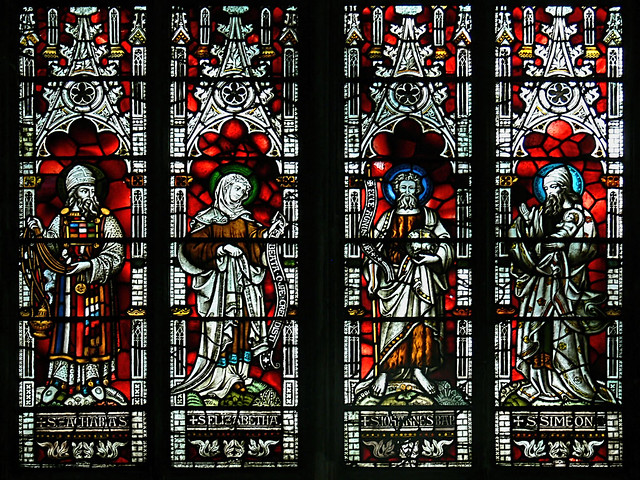Sts Zechariah, Elizabeth, John the Baptist, and Simeon - Quire Clerestory, Gloucester Cathedral
Submitted by walwynThese four stained-glass panels in the quire clerestory of Gloucester Cathedral were designed and executed by Clayton and Bell, one of the foremost English glass studios of the Victorian era. The sequence depicts Zechariah and St Elizabeth, the parents of St John the Baptist, together with St John himself and St Simeon, thus uniting within a single scheme the figures who herald and recognise the coming of Christ.
Each figure is rendered in a standing pose beneath richly canopied Gothic tracery, framed by an architectural border of white quarries and ruby grounds characteristic of Clayton and Bell’s late-medieval revival style. On the far left, Zechariah appears vested as a priest, censer in hand, representing his service in the Temple. Next stands St Elizabeth, veiled and draped in flowing robes, her calm expression embodying maternal piety. In the third light, St John the Baptist is shown as a youthful prophet clothed in his camel-skin mantle, holding the cross-staff entwined with a scroll inscribed Ecce Agnus Dei. To the right, St Simeon, the aged seer of the Presentation, tenderly cradles the Christ Child, his face uplifted in gratitude.
The ensemble reflects Clayton and Bell’s characteristic harmony of colour and line: soft modelling within luminous fields of red, gold, and white, animated by intricate diaper patterns and crisp leading. The figures, though idealised, are suffused with quiet humanity, their gestures restrained yet eloquent.
Installed during the later nineteenth-century restoration of the cathedral, these panels exemplify the devotional clarity and craftsmanship of the High Victorian Gothic Revival. By gathering together those who witnessed the revelation of Christ’s divinity, the window forms a visual meditation on faith, prophecy, and fulfilment, linking Old and New Testament expectation in a radiant continuum of sacred history.


